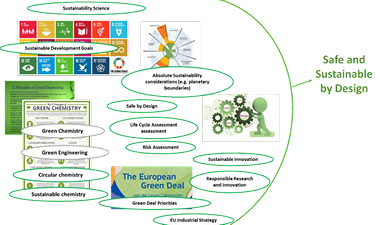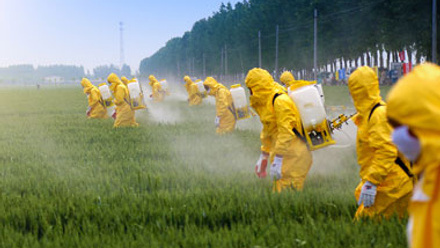Building Trust and Momentum on the Road to a Safe and Sustainable Chemicals Sector
Chris Hughes, Ricardo
This article was originally published on LinkedIn and adapted for the Globe.
A round table was hosted with leading industry scientists and policy experts in Europe to discuss the road to a safe and sustainable chemical sector under European regulations, as part of the event to celebrate the 50th anniversary of Ricardo’s National Chemical Emergency Centre (NCEC). This was a unique opportunity to bring together the views of key stakeholders at what is a crucial moment for the sector.
Held in the library of the historic Royal Institution in London, where for nearly two centuries the wonders of science have been communicated to a general audience in the famous annual Christmas Lectures, the venue was fitting for a far-reaching conversation that went to the heart of the role of chemicals in modern society and the existential challenges facing the sector. The discussion was held under the Chatham House rule to encourage open dialogue and enable the high-level outcomes to be shared. In the room were some of the largest chemical and consumer goods companies in the world.
The discussion began by hearing about the efforts of individual companies to improve sustainability across their portfolios. There were various examples of programs to screen inventories of chemical ingredients and products to identify those with the most hazardous properties. In addition to human and environmental toxicity, biodegradability came through as a key driver, particularly in consumer-facing sectors. Several companies had their own labs for carrying out biodegradation testing due to the challenges with these assessments and the need for high-quality data and expertise. It was clear that the environmental persistence of chemicals is rapidly rising up the priority list of issues for companies to address.
A huge sustainability transformation is taking place across the industry
As well as screening for hazardous properties, various other life cycle indicators of product sustainability were being used, including carbon footprint, land and water use. There has been a clear shift in emphasis towards renewable feedstocks across the sector with some companies setting bold targets for substitution of their existing portfolios. Another interesting development was in the use of social indicators for the portfolio screening. As well as considering this aspect in how products are made, at least one company was considering these factors downstream in their supply chain, incorporating ethical considerations of where the products were being sold to, and into which applications. It was impressive to hear about all the innovation and voluntary initiatives taking place in this space within companies, which will no doubt be important in driving progress towards sustainable development goals.
At the trade association level, there was a clear role being played in developing guidance and standards for the industry to follow. This was stressed as being really important for moving the entire sector forward on sustainability, and for supporting small and medium enterprises (SMEs), who are unlikely to have the resources or expertise to make the transition on their own. There was clear emphasis placed on being ahead of the curve, rather than simply tracking emerging regulation. This is important to show that the chemicals industry is serious about becoming sustainable, and to have the trust and credibility to shape better policy towards this goal. For consumer-facing downstream sectors, this was even more essential, with public opinion and consumer trends having always been a major driver of innovation.
Clearly, there is a huge sustainability transformation taking place across the industry. However, among companies, there is considerable variation in how this is being implemented. In life cycle assessment (LCA), there are a wide range of indicators of impacts that can be tracked and methodologies for doing this. A lack of standardization has led to companies adopting different approaches for their data gathering and reporting. Climate metrics naturally dominate the sustainability discussion and “carbon tunnel vision” has been highlighted as an issue that impedes a balanced and informed understanding of impacts. Nascent sustainability functions have emerged within companies with senior leadership backing, but the degree to which they are integrated with other functions such as those responsible for chemical safety and regulatory compliance varies, leading to silos in some cases. The extent to which sustainability data gathering and reporting was implemented in a “top-down” versus decentralized approach was also a source of difference. Several companies reported arriving at a balance between centralized provision of processes, tools and standards, with site-, product- or business-specific systems being developed that were able to capture the nuance and granularity of these separate areas. Clearly, the journeys of companies to implement these systems have been very individual.
Hazard versus risk is dead
The discussion moved on to the Safe and Sustainable by Design concept, a key component of the EU Chemicals Strategy for Sustainability. There was a collective feeling in the room here, and a sense of frustration that “safe” was really a pseudonym for “non-hazardous,” and largely neglected to consider the exposure and subsequent risks of these chemicals when used in their intended applications. This seems to reflect a broader shift in the political consensus around chemicals policy in Europe.
The previous day we had heard Cefic’s Director General, Marco Mensink, reporting in his opening keynote that “hazard versus risk is dead” and would get you nowhere in discussions with the European Commission. Instead, his advice was to “stop arguing safe use for a stupid use” and to use the “rule of my daughter,” which meant that if his teenage daughter would balk at it, you should expect a similar response from policymakers.
While some may celebrate this shift in the political mood, it was clear that the feeling in the room was grave. There was genuine concern that hazard-based approaches and an obsession with getting to zero (reference to the “Zero Pollution ambition” of the EU Chemicals Strategy) would ultimately lead to undesirable outcomes. The expansion of the so-called generic approach to risk management (GRA) was highlighted. This policy measure places an automatic restriction on the applications that chemicals with certain hazard classifications can be used in. It is proposed to expand the coverage of the GRA to include additional hazards and to include professional workers under the scope of applications that will be restricted. The potential economic impacts of the expansion of the GRA were recently analyzed in a study led by Ricardo, suggesting a substantial impact on the sector. The use of enzymes in laundry detergent was given as an example of where such an approach would be questionable. These ingredients are superior in their efficacy, biodegradability and general sustainability to equivalent chemical alternatives. However, they can be classified as respiratory sensitizers. Should their use be banned in such applications, despite the apparently negligible risk of such a hazard arising under the intended application?
The circular economy is often in conflict with hazard-based approaches
It was highlighted that the circular economy was often in conflict with hazard-based approaches, with applicable regulatory criteria reducing the demand for legacy materials, despite clear evidence for their safety, consigning them to the waste pile while new materials were having to be produced to meet societal needs. One attendee likened the situation to the contrasting philosophies of his parents: His father was always keen to conserve resources, recycling and repurposing items around the house, while his mother had an aversion to second-hand items, “You don’t know where it’s been.”
Of course, the circular economy certainly isn’t without its risks. The previous day, we had heard a discussion about the safety issues of transitioning to a new energy system, including the formidable challenge of lithium-ion battery fires and the bulk distribution of emerging fuels, such as hydrogen and ammonia. In the room, we discussed circular and bio-based feedstocks and the need to better understand the identity and risks posed by the chemicals within them. There was a question about chemical recycling technologies and the potential for the removal and/or transformation of certain hazardous chemicals within those processes. As we rapidly transition towards these technologies, we must be mindful and vigilant to manage their potential safety issues, as well as environmental, social and geopolitical challenges.
How did we get here
There was a sense of exasperation and “how did we get here” concerning the shift towards a hazard-based regulatory paradigm. The significance of this cannot be overstated as it effectively blows apart the scientific and political consensus around risk assessment as the tool that has guided societal management of chemicals for decades. The elephant in the room here were per- and polyfluoroalkyl substances(PFAS). These substances possess uniquely useful properties and have been used for decades in a plethora of applications. However, their chemistry, namely the strength of the carbon-fluorene bond, renders them highly resistant to degradation. This has led to them being referred to as ‘forever chemicals’ due to their extreme persistence. Recent evidence of the distribution and apparent accumulation of PFAS in the environment, along with growing concern about their effects on human health, have provoked widespread outrage and alarm, and a tidal wave of legislation and litigation that threatens to engulf the industry (put succinctly by Mensink, “It’s a nightmare”). The latest chapter in the saga is the use of do-it-yourself kits (courtesy of the infrastructure created by the COVID pandemic) to sample and analyze blood levels of various PFAS chemicals, which recently has been taken up very publicly by the chemical non-governmental organization (NGO) ChemSec and various Members of the EU Parliament. Such developments are unprecedented and have the potential to upend the entire regulatory system in Europe, with the public taking matters of their exposure to chemicals into their own hands. The proposed universal restriction of PFAS under REACH is further evidence of the seismic shifts being brought by the PFAS issue (the European Chemicals Agency recently received a staggering 5,600 comments during its public consultation on this restriction).
We live in an exposome
It should come as no surprise to scientists knowledgeable of risk assessment, whether from industry, academia or government, that we live in an exposome. That is, we live in constant low-level exposure to chemicals in the food we eat, air we breathe, water we drink, and environment we live in. This is a necessary trade-off of living in a society that enjoys all the benefits and human well-being brought by technologies utilizing chemicals. However, this fact has largely lived outside of the realm of public consciousness, until recently. Like many issues, there is often a threshold or trigger that brings these issues to the fore. However, once the issue comes alive in the public consciousness, policy change is sure to follow.
Along with PFAS, there has also been the scourge of plastic pollution and widespread reporting in the media of the occurrence of small particles (referred to as microplastics) in remote environments and in our bodies has undoubtedly been a catalyst. It might be quite understandable for the public to feel revulsion upon becoming aware of these realities and consider it a violation that they had not consented to. As the coverage of environmental and human biomonitoring, and the sensitivity of analytical methods increases, instances of exposures to ever more chemicals will inevitably come to light.
A new wave of activism
With these revelations, we also have a new wave of activism, with NGOs and certain sections of the scientific community employing hugely effective strategies to push specific agendas. These strategies employ social media and novel forms of communication, often blending adept science communication with emotive messaging to great effect. These activities are understandably seductive as they also help to raise the profiles of the individuals and organizations involved, an unfortunate feedback loop symptomatic of the “social media age” in which we live. We also sadly see more and more instances of tribalism and ad hominem attacks on the science and arguments put forward by industry, dismissing these as mired in “conflicts of interest” and therefore not worthy of consideration. In the wake of these challenges, it is no wonder that the industry has struggled to engage in this debate.
However, it was recognized that there is an urgent need to restore trust and for a broader societal discussion about how we use chemicals in the context of the global sustainability agenda. This will need to take place transparently and in a way that maximizes human flourishing, while ensuring proper care and stewardship of the environment. The sense was that the public understands the concept of risk and should be better included in this conversation so that they can truly understand the choices, trade-offs and implications of the current direction of travel. After all, people make risk assessments in their daily lives all the time, from choosing when to cross the road to what to eat and drink later that evening.
The public needs to have more information on the risks and impacts of their daily choices from a sustainability perspective. This could come in the form of life cycle indicators on product packaging. Just as when choosing between political parties (and their various policies) in a democratic society, individuals could weigh individual health, environmental and social impacts of the products they purchase according to their own values. However, in order for this to work effectively, a harmonized approach for assessing product life cycle impacts would be needed. This could be a role for the product environmental footprint (PEF) methodology currently under development at the EU level. The silos between the risk assessment and LCA communities would need to be broken down – those within the SETAC community would be a great start here – and a pragmatic list of indicators agreed from the current laundry list of areas of academic study. Finally, the impacts of products would need to be able to be weighed against realistic estimates of potential harm to health and the environment, which in order to be balanced and effective would necessitate a risk-based approach.
Against this backdrop, it is surely a time for collective responsibility
It's clear that the chemicals industry faces huge challenges in the current political and regulatory climate. However, to reduce this to only a problem caused and faced by the industry is at best an oversimplification. The reality is that we have built our society around the use of chemicals, and scientists from all camps have been complicit in constructing the system of risk assessment that has brought us to where we are today. Against this backdrop, it is surely a time for collective responsibility. Of course, the chemicals industry has its fair share of responsibility to take and should own its past mistakes and implement safeguards for the future. However, other sections of the scientific community should also show responsibility in how they perform, report their research, and engage in policymaking. The pursuit of the truth is of course the highest ideal of the scientific enterprise, and all scientists should be vigilant to guard against perverse incentives, blind spots and personal egos that might lead them to deviate from this guiding star. Ultimately, in this age of societal, geo-political and environmental crises, it is imperative on all parties to engage in scientific discourse with honesty, integrity and generosity, so that we might hope to find solutions to the multiple complex challenges we face.
Author's contact: [email protected]





